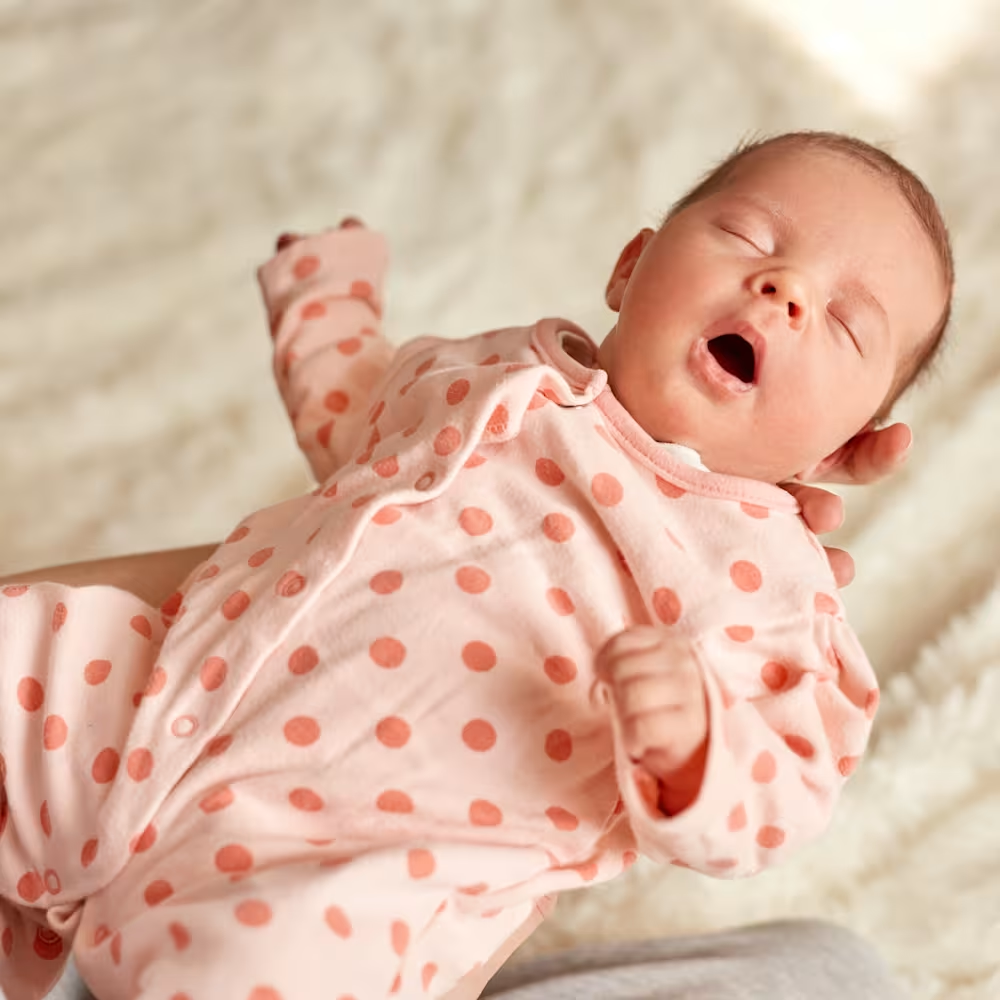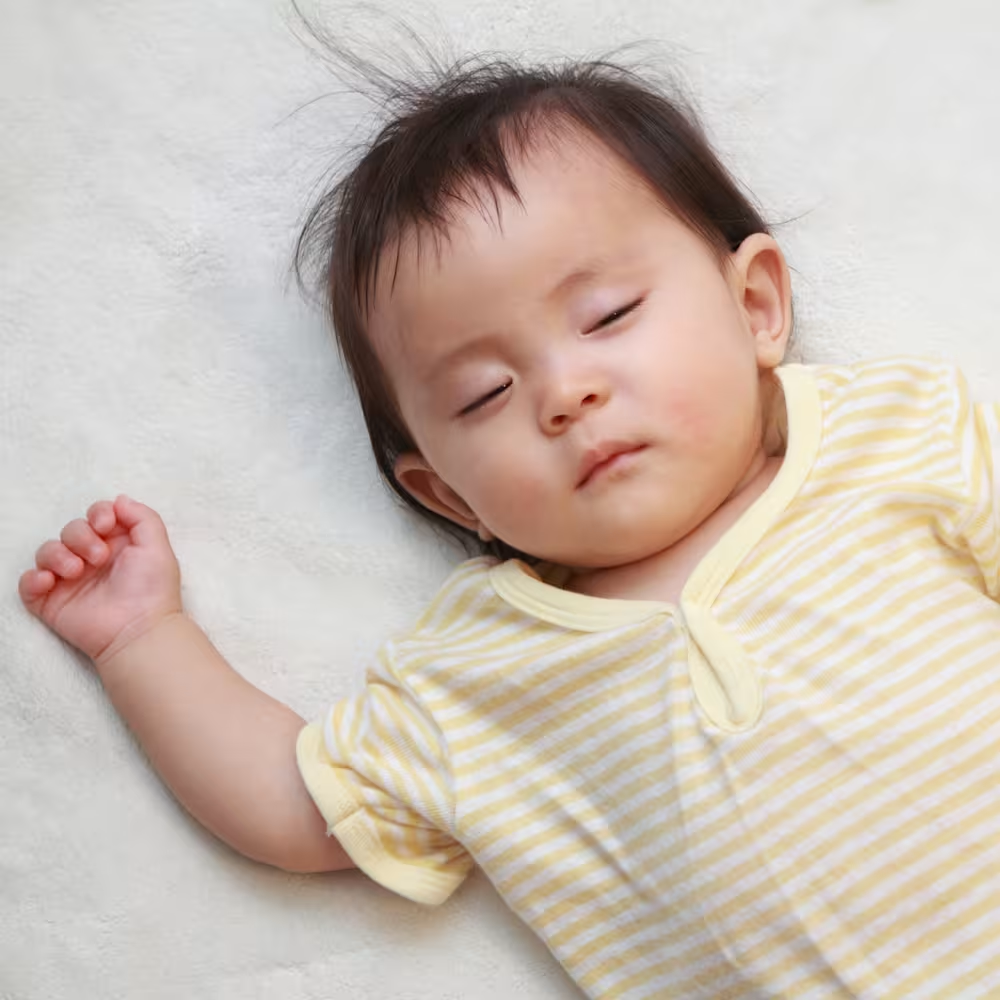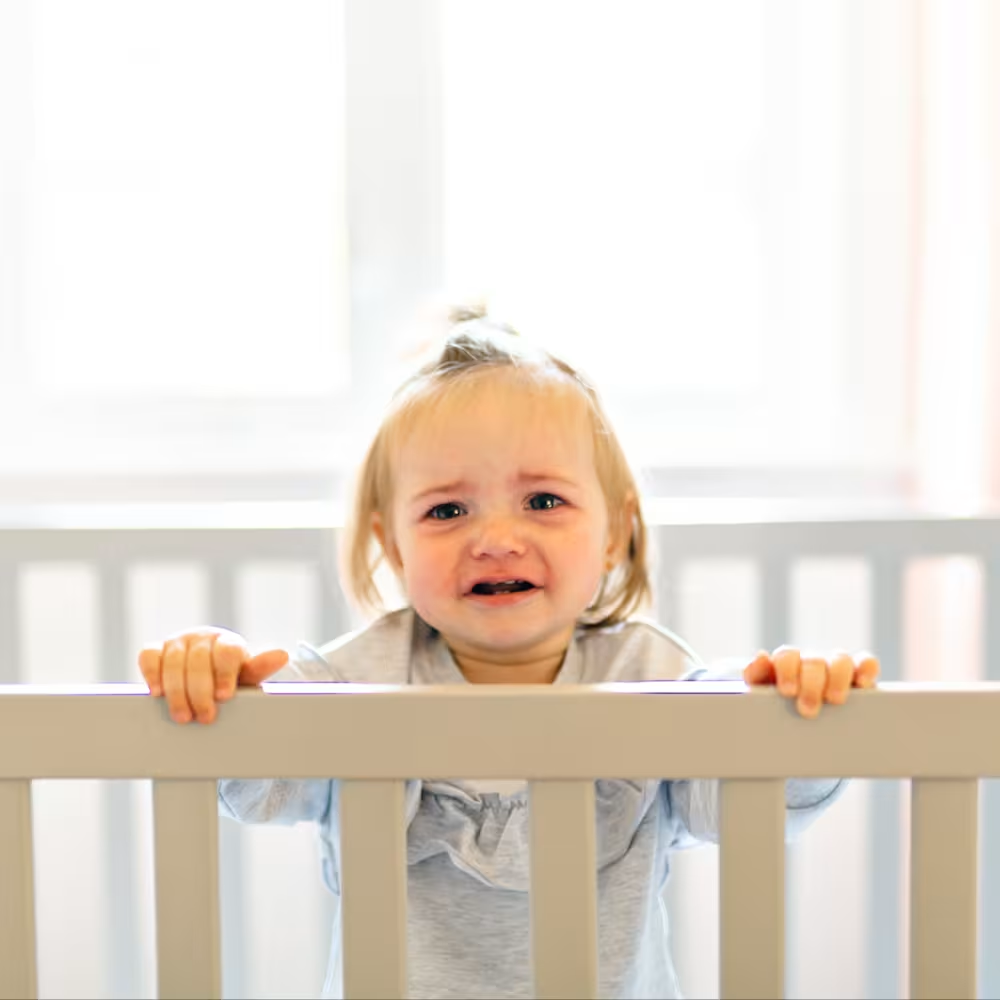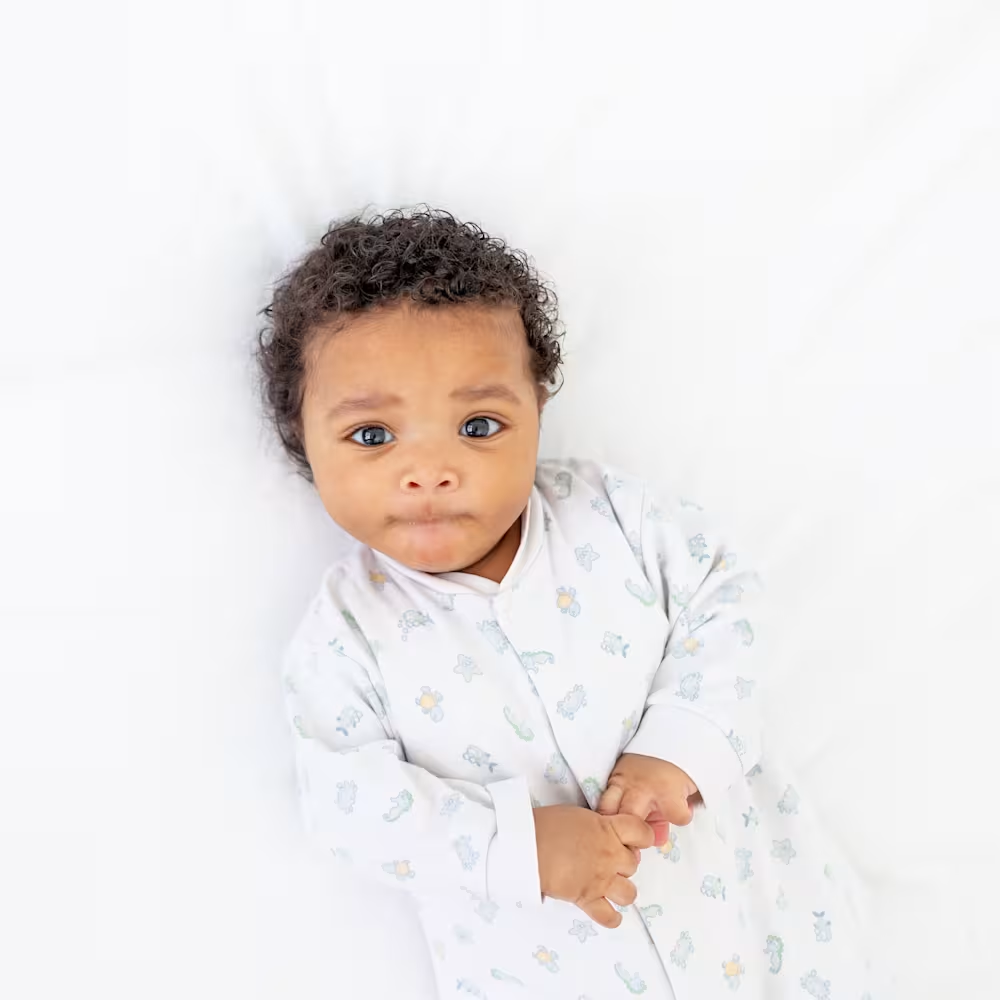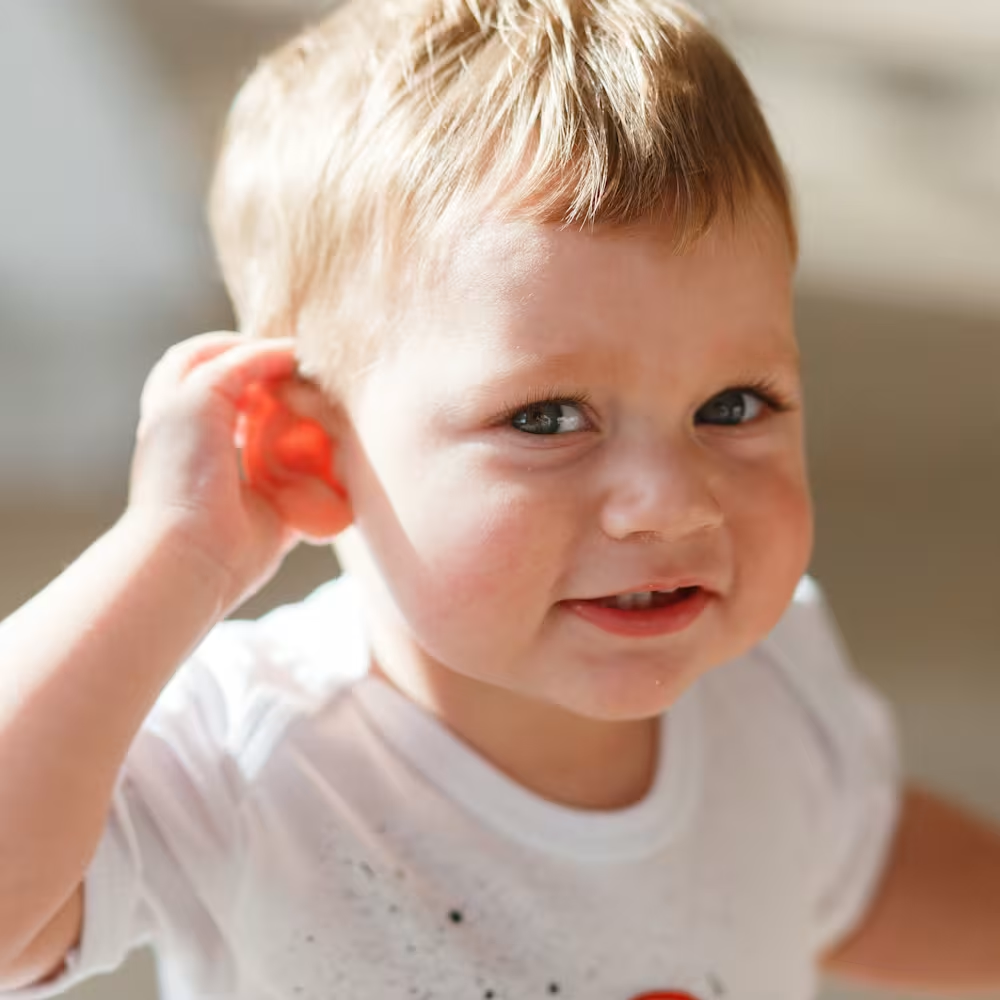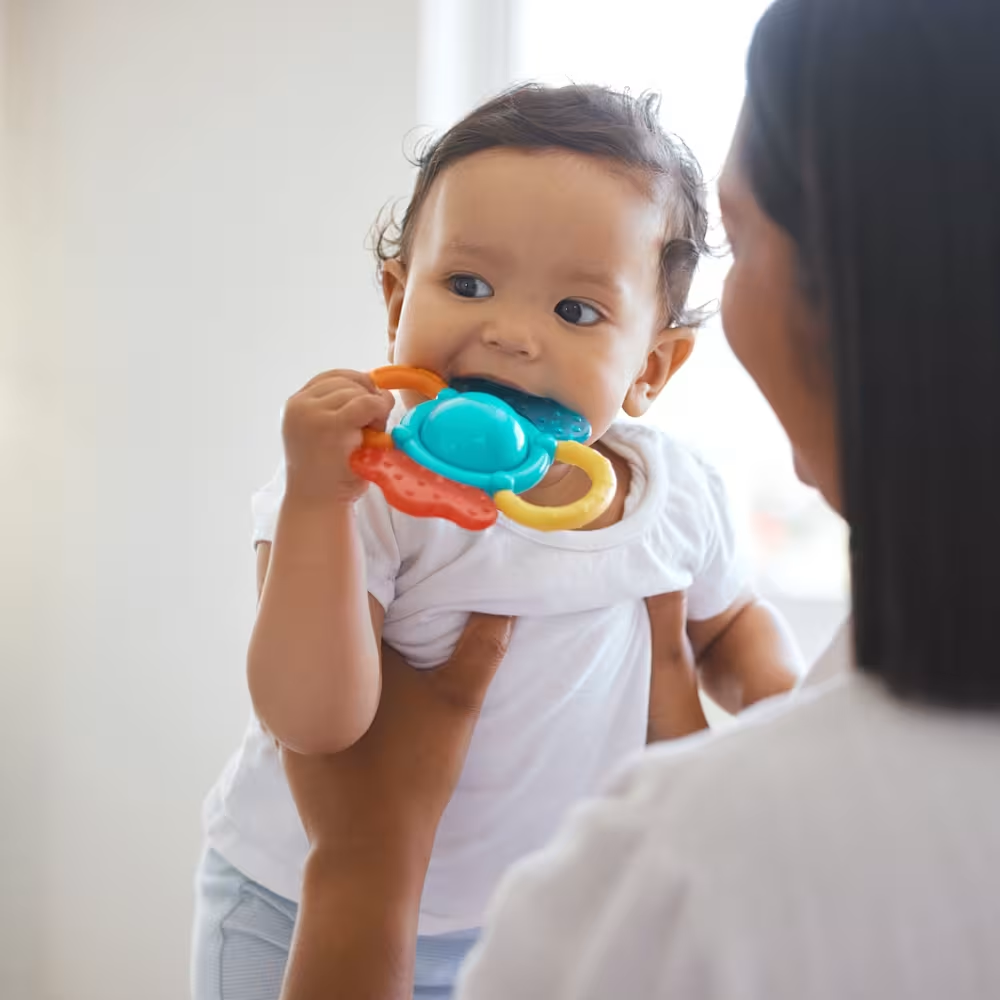Why is my child sweating so much at night? What’s normal & what’s not
Updated Oct 16, 2025
Up-to-date

If your baby or toddler wakes up with a sweaty head or damp pajamas, you might wonder if something’s off — or if you’re just raising a tiny furnace. The good news? Sweating during sleep is pretty normal for little ones, especially when they’re in deep sleep []. Most of the time, it’s nothing to worry about ( if your kiddo wakes up sweaty but doesn’t have a fever). Still, if the sweating seems excessive or comes with other symptoms, it’s worth checking in with your pediatrician.
Table of Contents
Night sweating in children: What caregivers notice
Every kid is different, but here are some everyday things caregivers report when night sweating shows up:
“My toddler’s hair is soaked every morning. It’s like they just stepped out of the bath!”
“My child wakes up with a wet pillow, even though the room isn’t hot.”
“Their PJs are damp, but my child doesn't seem uncomfortable or sick.”
“Their head is sweating right after they fall asleep, even before I’ve had a chance to sneak out of the room.”
“I thought they had a fever, but their temperature is normal.”
“They sweat so much at night, I’ve started keeping an extra set of sheets on standby.”
The sweating you’re noticing might be local (just the head, face, or neck) or general (all over the body). Either one can be normal, especially if it doesn’t come with other symptoms. Still, if your child’s nighttime sweating seems to disturb their sleep or they seem flushed, clammy, or unwell, it’s worth keeping an eye on and bringing it up with your pediatrician. You know your child best — if you notice any red flags, it’s often best to err on the side of caution.
Why do babies and toddlers sweat during sleep?
You’re not imagining it — little ones really do run warm. Babies and toddlers are more prone to night sweats for a few simple (and usually harmless) developmental reasons:
Their temperature regulation system is still developing. Babies can’t regulate body heat as efficiently as adults [], so they may overheat or sweat more easily, even when the room feels comfortable to you. Sweating signals that their little bodies are doing their best to stay cool [].
Their sleepwear is too warm. Thick or fleece pajamas that are less breathable can trap heat and cause sweating.
The room is toasty. If the room they sleep in feels warm, it can make it harder for kids to stay cool while they sleep, making sweating more likely.
In less-common cases, there may be underlying medical conditions. Occasionally, night sweats can be linked to underlying health issues, like fever, asthma, allergies or mild infections. If your child sweats a lot at night and is also experiencing other symptoms (think: poor sleep or weight loss), check in with your pediatrician.
Sweating only from the head: Should you worry?
It can seem a little strange when your child wakes up with a sweaty head when they’re dry everywhere else. However, sweating only from the head is usually not a cause for concern. In most cases, sweaty heads are more of a laundry issue than a medical one!
Here’s why it happens:
The head is a heat-release zone. Children tend to lose a higher percentage of body heat through their head (compared to adults) due to their head being proportionately bigger []. Head sweating is usually a normal way their developing body regulates heat.
The rest of their body may stay dry. This can be totally normal, and it doesn’t mean your child is sick or overheated overall.
Warm surfaces can trigger head sweating. If your little one is lying on a warm or less breathable mattress, or , that can trap heat and lead to more sweating. (Note: For safety, the AAP recommends babies under 12 months sleep on a firm, flat surface without pillows or soft bedding.) []
How night sweats can affect your child’s sleep
Night sweats can make it harder for your child to sleep well. Overheating may lead to restlessness, night wakings, or early rising. Once their body cools down, they might feel cold or sticky, which can make it difficult to fall back asleep without help, such as a change of clothes or sheets. If night sweats are frequent or seem excessive, it’s worth exploring possible causes like illness, overdressing, a warm sleep environment, or certain medications.
Common reasons for toddlers sweating at night
Before you start panic-Googling at 2 AM, know that most night sweats in babies, toddlers, and young children have a harmless explanation. In most cases, it’s nothing to worry about and can often be solved with a few tweaks to your child’s sleep setup.
Some of the most common reasons include:
Warm or heavy pajamas. Fleece footies might be cute, but they can trap heat fast.
Too many layers. Over-bundling at bedtime (extra blankets, footie pajamas, or hats) can cause your child to overheat even in a cool room.
High room temperature. Most experts recommend a room temperature of 68° - 72°F range, but that’s not always doable, especially in the summer []. If the room feels hot to you, it may feel even warmer to your kiddo!
Natural variation and genetics play a role. Some kids are just sweaty sleepers — and that can be totally normal.
Crying before sleep. Big emotions at bedtime or discomfort (like ) can lead to extended crying at bedtime, which may raise your child’s body temperature and trigger sweating.
Recent activity before bed. If your child was running, jumping, or doing toddler parkour right before lights out, their body might still be cooling down when they hit the pillow.
Teething or minor illness. Sometimes, sweating can happen if your child is experiencing mild discomforts like teething or the , even when there’s no fever [].
What else could be causing night sweats? (Less likely, but worth knowing)
In less-common cases, night sweating in kids may be tied to underlying health conditions, most of which involve the nose, throat, or lungs. Children with allergies, asthma, eczema, or even enlarged tonsils may be more likely to experience night sweats, especially if they also snore or have disrupted breathing during sleep. There is also a correlation between kids who experience hyperactivity, anger, and issues with extreme emotional dysregulation and sweating a lot when sleeping.
Other less-likely causes of nighttime sweating in young kids include:
Sleep apnea []
Throat infections, including chronic tonsillitis, strep throat, and laryngitis
Skin conditions, like eczema []
Extremely rare childhood conditions, like lymphoma and leukemia, may include night sweating as a symptom, but would almost always come with other signs like fever, fatigue, weight loss, or trouble breathing [].
These causes are uncommon, but if sweating shows up alongside other health changes, talk to your pediatrician to rule them out.
Certain medications can also cause night sweats in kids, but your doctor will likely let you know about those side effects, what to expect, and how to manage them when prescribing your child.
Is sweating at night normal? What’s typical vs. what’s not
Some sweating during sleep is totally expected for kids. But how can you tell what’s just part of growing up and what might need a closer look? Here’s a quick comparison to help you figure out what’s within the “normal” zone and when it might be time to call your pediatrician:
Normal sweating | May need medical attention |
Damp hair or neck | Drenched clothes or sheets regularly |
No fever or other symptoms | Fever or weight loss |
Happens occasionally | Happens every night, or seems to be getting worse |
Child sleeps well and seems otherwise fine | Child is restless, uncomfortable, or breathing rapidly |
If you’re ever unsure, trust your instincts and reach out to your pediatrician. You’re not overreacting for wanting to understand what’s going on with your kiddo’s sweaty sleep.
When to see a doctor about night sweating
While most night sweating in children is not an issue, there are times when it’s worth getting checked out []. Give your pediatrician a call if you notice:
Sweating with a persistent fever (especially one lasting more than 2 days or getting worse)
Rapid or noisy breathing, mouth breathing, or wheezing during sleep
Night sweats are happening every night, especially if they’re soaking through clothes or bedding
Snoring or signs of sleep apnea [], like sucking in the stomach while breathing
Cold and clammy skin along with discomfort or restlessness while sleeping
Loss of appetite, weight loss, or poor growth
New or unusual body odor, or sweat that smells different than usual (this can be a sign of hormone changes or another health issue)
Other physical symptoms, like ear pain, stiff neck, diarrhea, or vomiting
Your child seems uncomfortable, restless, or overtired during the day, despite getting the recommended hours of daily sleep for their age
You just have a gut feeling that something’s off (Trust your intuition!)
Do kids need treatment for night sweats?
In most cases, nope. Occasional or even regular night sweating — especially in younger children and toddlers — doesn’t need treatment at all. It’s just part of how their bodies are growing and learning to regulate temperature.
But if your child’s sweating is extreme, constant, or comes with other symptoms, your pediatrician might want to run a quick check. Tests like the starch iodine test (swabbing a solution onto your child’s skin to find excessively sweaty areas) or a simple paper test (placing a special kind of paper on areas where your child sweats) can help pinpoint where the sweating is happening — but most of the time, they’re not needed [].
Overheating
Sweating while sleeping isn’t dangerous on its own, and is usually just your child’s way of cooling down. However, sweating sometimes signals that your child is overheating, which can be more serious. For babies especially, overheating is a known risk factor for sudden infant death syndrome (SIDS) []. That’s why it’s important to keep the environment cool and dress your kiddo in nighttime clothing that’s just enough to keep them cozy, not over-bundled.
Tips to keep your child comfortable at night
If your little one is waking up sweaty, a few simple tweaks can help them sleep a little drier:
Keep the room cool. Aim for a cool room temperature year-round. A fan or slightly cracked window can help with air circulation [].
Dress them lightly. in breathable, natural fabrics like cotton or bamboo if possible. Skip the fleece footies unless it’s really cold.
Limit layers. A for babies or a single blanket for toddlers is often enough, even if it feels chilly to you.
Use breathable bedding. Whenever you can, swap out heavy or synthetic sheets for lighter, more breathable options.
Skip the hat. Babies and toddlers release a lot of heat from their heads, so covering them up can trap that heat and lead to more sweating.
Cool them down before bed. A lukewarm bath or like story time can help bring their body temperature down before lights out (especially if they’ve been zooming around before wind-down time!).
Track patterns. If you notice frequent sweating, consider using the free Huckleberry app to keep tabs on when and how often it happens. This information can be helpful if you end up talking to your pediatrician.
Manage underlying conditions. If something like asthma or is part of the picture, make sure these conditions are being addressed with your pediatrician.
These comfort tips may not completely prevent night sweating, but they can definitely help your child stay cozy (not clammy) as much as possible.
Takeaway
Sweating during sleep is common for babies and toddlers, especially on their heads.
Most cases aren’t a cause for concern. Night sweating in kids often comes down to deep sleep, warm pajamas, or a toasty bedroom.
Simple changes can help. Cooler rooms, lighter clothing, and breathable bedding can make a big difference.
Watch for red flags like fever, rapid breathing, or poor growth.
Child night sweating FAQs
Share article:
Note: The content on this site is for informational purposes only and should not replace medical advice from your doctor, pediatrician, or medical professional. If you have questions or concerns, you should contact a medical professional.
12 Sources
Table of Contents
Share article:

